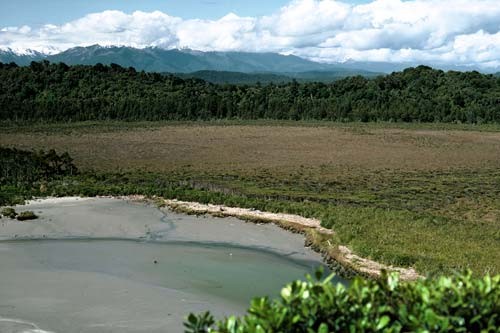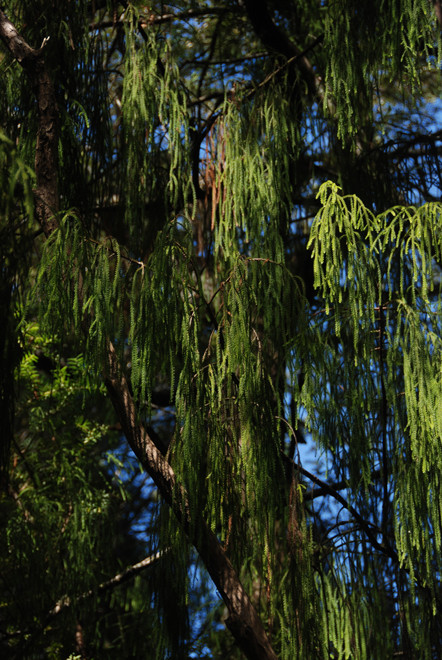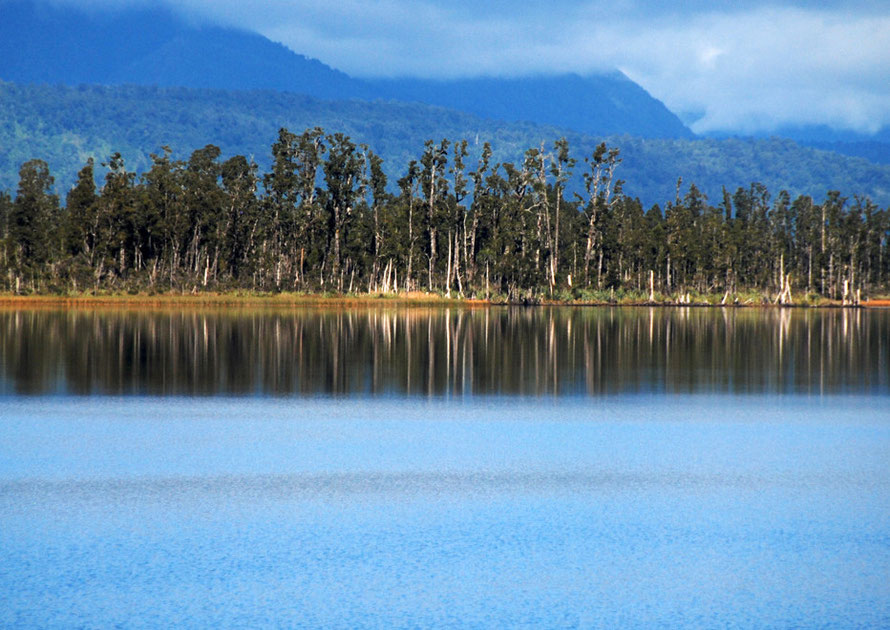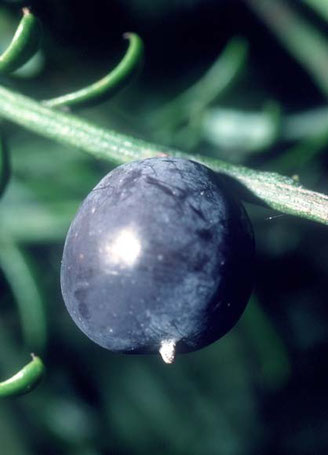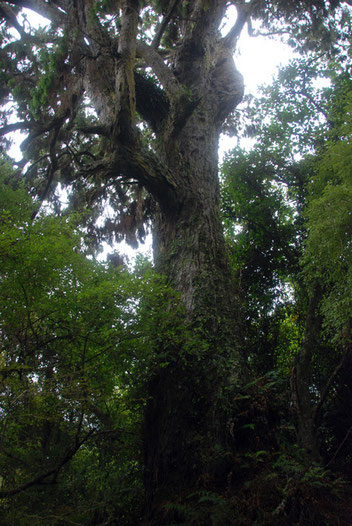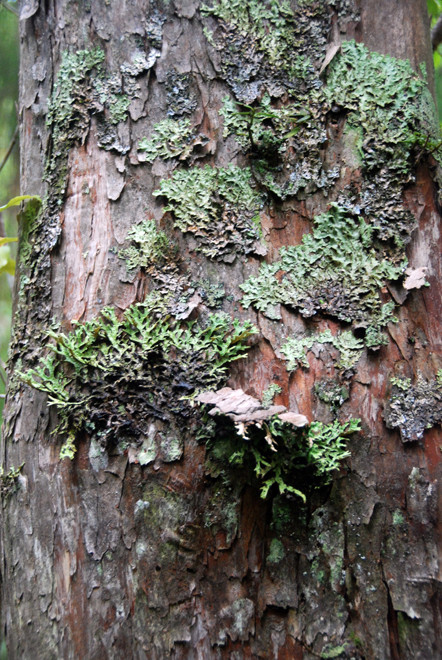II. The New Zealand Podocarps
The Mystery that is the 'Podocarp'
The New Zealand podocarps are for me one of the most confusing groups of trees I have come across. I kept seeing references in guide books, leaflets and interpretational signage to these things called 'podocarps' but they never said what they were.
And the strange 'podocarps' have even stranger Maori names - totara, rimu, matai, miro and kahikatea - that are then rendered into translations that all include the word 'pine'.
This was the settler way of making sense of difference and dominating the threatening Other by forcing its difference into the familarity of classifications that had come from the known and safer (at least in some ways) Mother Country.
But this juxtaposition and elision of the familiar and exotic that signals an uneasy truce between colonial (European) and post-colonial (Maori/Pacifika/Pakeha) discourses makes it hard sometimes to understand what the hell is going on.
That is exemplified in the 'podocarp' which is exotic, different, unique, ancient and yet is reduced to the familiarity of names such as 'White', 'Black', 'Yellow' and 'Yellow Silver' Pine.
But the whole thing about the podocarp is that while it is part of the very wide plant division of 'conifers' it is not a pine as we would understand it in the Northern hemisphere.
Why is that? Because it doesn't have pine cones and it doesn't have pine needles as your northern hemisphere logger would understand them. Indeed, that is what 'podocarp' precisely eludes to in its obscurantist latinate naming system.
For podocarp literally means 'foot-seed' where the seed of the female plant (unhelpfully the podocarp is also diecious - comprised of distinct male and female trees) lies below the fruit of the tree rather than - as is the case in the northern hemisphere pine - being enclosed by it (in a pine cone).

The large podocarpaceae family is a member of the conifer (Pinophyta) division of plants.The conifers are part of the gymnosperms (gymno - naked/ sperm - seed) that evolved 350 million years ago and before the flowering plants (the agniosperms - vessel-seeds).
The conifer family members in New Zealand are:
- the podocarps (eight genera and 14 species)
- the Araucariaceae family containing one species - the kauri (Agathis australis)
- the celery pines (Phyllocladaceae with three species)
- the cypress (Cupressaceae with two species)
The podocarp family has the most genera and species of the conifer division in New Zealand.

'Podocarpaceae is a large family of mainly Southern Hemisphere conifers, comprising about 156 species of evergreen trees and shrubs' (Wikipedia) containing 19 genera. Members of eight of these genera occur in New Zealand.
The family [which] ... shows great diversity, both morphologically and ecologically ... is a classic member of the Antarctic flora [originating from the supercontinent of Gondwana], with its main centres of diversity in Australasia, particularly New Caledonia, Tasmania and New Zealand, and to a slightly lesser extent Malesia and South America.
Within the family podocarpaceae there are eight genera extant in New Zealand. These are:
- Podocarpus - the five species of Totara
- Dacrydium - the Rimu is the only species in New Zealand
- Prumnopitys - the Miro and Matai
- Dacrycarpus - the Kahikatea is the only New Zealand species
- Halocarpus - the Bog and Yellow Pine
- Lepidothamnus - the Yellow-silver and Pygmy Pines
- Manoao - the Silver Pine
The kauri is not a podocarp but a genus (Agathis) that belongs to the ancient Araucariaceae family of conifers (that includes the Chilean 'Monkey Puzzle').
(Sources for these pages include Wikipedia, the New Zealand Plant Conservation Network, the Taranaki Educational Resource: Research, Analysis and Information Network and the Gymnosperm Database. Many thanks to all three of them for the excellent information.)
Kahikatea (Dacrycarpus dacrydioides) 'White Pine'
Etymology: Dacrycarpus = tear-shaped fruit
Kahikatea swamp forests on the West Coast like that at the southern end of Lake Ianthe/Matahi are 'the nearest replica of the type of primeval forest that would have existed 80 million
years ago at the time of separation from Australis' (Gibbs Ghosts of Gondwana). Once called 'white pines' they differ from pines because they do not have woody pine cones. Instead, their female
cones are reduced to single scales that ripen into solitary seeds surrounded by or sitting on brightly coloured, fleshy structures that attract birds (Te Ara).

The kahikatea has separate male and female (dioecious) trees and is New Zealand's tallest tree. It can grow up to 55 metres (180 ft) (a living specimen achieved 62.57 metres in 1996/7) and live for 500 hundred years. Of the New Zealand podocarps it can be traced furthest back into the fossil record - perhaps to Mesozoic period 200 MYA (RFBP: 50).
The trees grow in wet ground on lake and river marshes. They can support themselves through their interlocked root mats on semi-liquid peat. The spongy roots 'enable them to oxygenate their rootlets and thus survive in waterlogged soils that few other trees can tolerate' (Forest, Fiords and Glaciers RFBP p.50).
Kahikatea forest is increasingly rare, particularly in the North Island, where it was cleared for its timber (it has no odour and although not very durable was excellent for butter boxes) (see here for the 'slaying of the kahikatea') and for the flat farmland that could be developed from drained marshes. In the South Island acreages of dense kahikatea stood at 4,500Ha in 1987 and it is said to be 'as scarce as kauri' and more vulnerable to logging due to a lack of protection (ibid p.50).
The seed covers (aril) ('koroi' in Maori) were eaten by Maori and heartwood charcoal was used to make a tattooing (ta moko) pigment (Wikipedia). The seeds only occur on the female tree.
'A large mature kahikatea yielded 300 pounds (136 kg) of sound seed, representing 4.5 million seeds' (Gymnosperm Database). This is important food for tui, bellbirds and kereru (pigeons).

Bark dark grey, covered irregularly with small protuberances ca. 1-2 mm across and 1-2 mm high, scaling off in large, ovoid flakes.
Matai (Prumnopitys taxifolia) 'Black Pine'
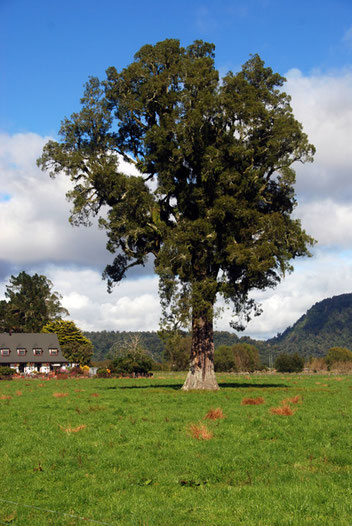
Etymology: Prumnopitys: From the Greek prymnos 'hindmost' or 'stern' and pitys 'pine', referring to the location of the resin duct. Taxifolia - like yew leaves - taxus in Latin.
We passed by a majestic matai tree 'Black pine' (Prumnopitys taxifoliatree) on the Whataroa Flats. It has a thicker, fluted trunk that the kahikatea and is part of the podocarp family. It grows to 25-30 m tall and the trunk is 1-2 m in diameter.
Its seeds are dispersed by the Kereru/New Zealand Pigeon (Hemiphaga novaeseelandiae). It feeds on the matai berries and thus disperses them. It is a different genus from the European Wood Pigeon.
The hard timber of this tree was used extensively for flooring during the mid-20th century. Very few intact Matai-dominated forests remain (Te Ara).
With a broad crown on stout upright spreading branches it grows on the North Island and South Island. It also occurs on Stewart Island/Rakiura (47 °S) but is uncommon there. It grows up to 33 m high, with a trunk up to 2.35 m diameter and is thought to have a life span of a 1000 years.
Matai prefer well-drained flood plains and deep pumice deposits, and at one time matai/totara forests occurred throughout New Zealand.
'Both matai and totara can produce new root systems from their trunks after silt is deposited around them' (see McSWEENEY: MATAI/TOTARA FOREST IN SOUTH WESTLAND, NZJEcol 5 1982 p. 125).
Matai is not threatened, although as a forest-type it has been greatly reduced through widespread logging. It also tends to occur on the best alluvial agricultural land (see TERRAIN).

Mataī has a distinctive and long-lasting juvenile stage unlike the related Miro (Prumnopitys ferruginea). The juvenile is a shrub with a tangle of slender, flexible, divaricating branchlets interspersed with a scattering of brown, pale yellow, or dirty white leaves. After a number of years, the adult tree begins to grow out of the top of the juvenile shrub and then the divaricating branchlets will wither and drop off.
Wikipedia: Matai quote
This was a defence against browsing by birds, particularly the now extinct Moa. Divarication appears to be a particular evolutionary response in a New Zealand absent of mammal browsers (see Gibbs Ghosts of Gondwana pp162-6.)
Once the Matai is above the height of the largest Moa browser it conforms to a more 'natural' tree-growing strategy. Putting all its eggs into one basket too early - by only having a central growing tip - might have rendered it vulnerable to attack, growth-point-splitting and slower growth towards the light in the competitive conditions of scrub and forest clearings.
A survey of matai (Podocarpus spicatus) / totara (Podocarpus totara var. waiho- ensis) forest in South Westland recorded that c. 600 ha of these forests remain from a possible former 43,000 ha. (McSWEENEY: MATAI/TOTARA IN SOUTH WESTLAND NZJEcol 5 1983).

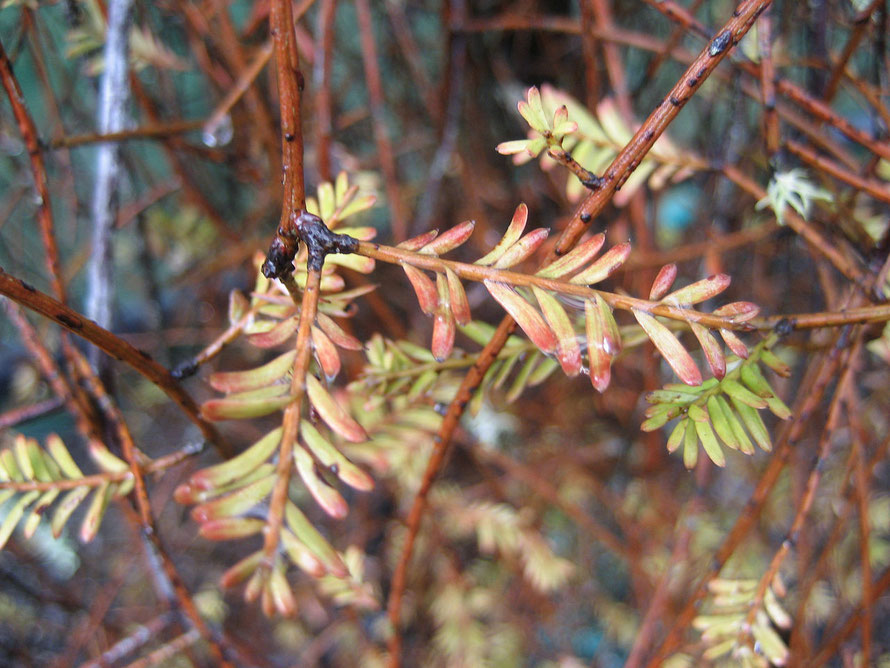

Miro (Prumnopitys ferruginea) 'Brown Pine'
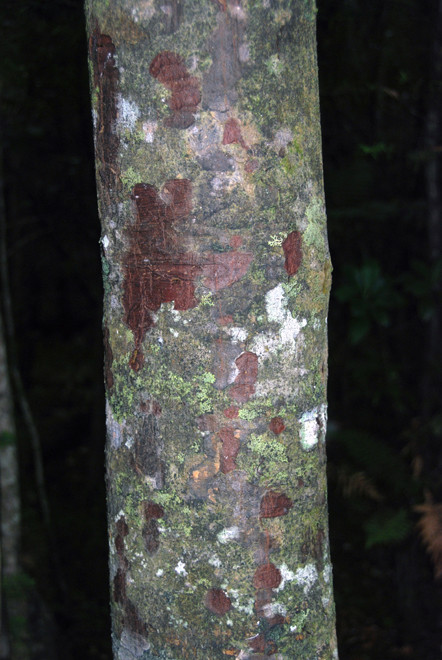
Etymology: Prumnopitys (see above) ferruginea (iron-like, rusty coloured)
Grows to 25m, a stout tree, trunk similar to Matai, but foliage supposed to be easily identifiable. Appears finer and more pointed than 'banana-shaped' foliage of Matai. 'The bright green to bronze-green, feathery foliage, and pink-red, to red plum-like drupes are quite unlike any other New Zealand conifer' (NZPCN)

Rimu (Dacrydium cupressinum)
Etymology: Dacrydium: tear drop. Cupressinum: cypress
Rimu is longer lived than the kahikatea and can live to 800 years. Slow growing and able to tolerate poor soils, it can develop very dense stands husbanding its nutrient supply in its great bulk and the leaf litter it sheds (Forest, Fiords and Glaciers RFBP p.51).
Grows to 35-60m tall. Adult trees have a trunk bare of branches for 3/4 of length. Flaky, dark brown bark. A round-topped crown with strong lateral branches bearing pendulous branchlets and foliage when mature.
Bark is dark brown or grey, stringy, usually pimpled, and peels in long, thick flakes
Lowland to montane forest - occasionally ascending to subalpine scrub.
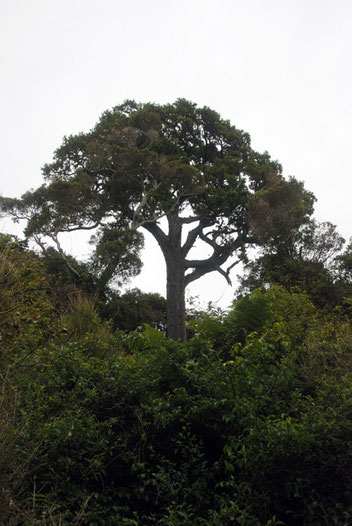
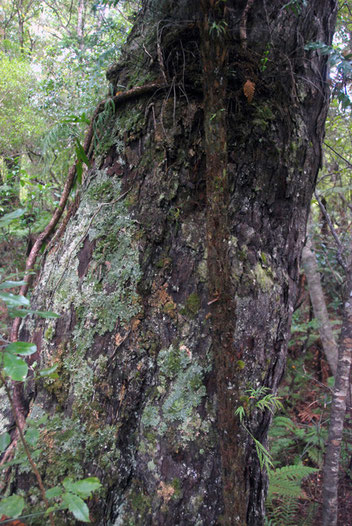

Halls Totara (Podocarpus cunninghamii)
Also called Mountain or Thin Bark Totara. Maori: totara-kiri-kotukutuku
Robust up to 20 m tall. Trunk stout, 1-1.5m diameter clad in papery, thin, freely flaking reddish-grey bark.
Totara (podocarpus totara)
Bog Pine Halocarpus bidwillii
Etymology: Halocarpus from Greek hals 'sea', 'salty' and karpos 'fruit'
A spreading or erect, closely branching shrub, or occasionally a small tree up to 3.5 m tall, with a short trunk up to 38 cm in diameter.
A scrubby pine with erect foliage and distinctive white fruit above the seed.
Yellow Pine Halocarpus biformis
Lepidothamnus laxifolius (soft-leaved)
Small tree up to 10 m tall. Likes rich soil.
Pygmy Pine (Lepidothamnus laxifolius)
Lepidothamnus laxifolius (soft-leaved)
A prostrate or semi-erect mini-pine found in mountain areas.
Yellow silver Pine (Lepidothamnus intermedius)
Small, straight tree up to 15 m with spreading branches. Bark brown-grey, shed in small platelets, under which the new bark is red-brown.
Relatively widespread and common tree of lowland forests. Locally dominant in swamp forests. Also found in boggy areas in shrubland or grassland.
Manoao Silver Pine
Widespread. Up to 20m tall. Slow growing.
Lowland to montane. Typically associated with older, poorly drained surfaces with leached infertile soils, and in acid swamps and peats, notably the pakihi lands of western South Island.

